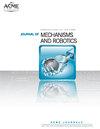Kinematic modeling and optimization of a clustered tensegrity mobile robot
IF 3.2
4区 计算机科学
Q2 ENGINEERING, MECHANICAL
Journal of Mechanisms and Robotics-Transactions of the Asme
Pub Date : 2023-08-30
DOI:10.1115/1.4063290
引用次数: 0
Abstract
Clustered tensegrity mechanisms have elicited extensive attention in recent research due to their easy control system and high stiffness-to-mass ratio. However, modeling and analyzing these mechanisms are still challenging due to the clustering of cables and redundant structural parameters. This paper proposes an energy-based kinematic modeling method for a modular clustered tensegrity mobile robot. The design of the clustered tensegrity robot is inspired by the biomechanics of worms, allowing it to achieve two locomotion modes resembling earthworm-like and inchworm-like movements using two motors. Moreover, the clustered and modular structure enables the robot to increase the number of modules as needed without increasing the number of actuators. This feature enhances the robot's terrain adaptability without adding complexity to the control system. The paper establishes kinematic models using the energy method and clarifies the motion law of nodes on the sliding cables of the robot, considering multiple structural parameters for both locomotion modes. Based on these models, the paper reveals the mapping relationships among various structural parameters (i.e., cable-hole gap, cable-hole friction, stiffness and original length of elastic cables, and ground-robot friction) and locomotion performance (i.e., morphology, displacement, and velocity) of the robot. Furthermore, structural parameter optimization is performed to enhance the kinematic performance of the robot in both locomotion modes simultaneously. A prototype with two modules is developed, and experiments are conducted to assess the robot's locomotion performance. These experiments demonstrate the effectiveness and rationality of the proposed method.集群式张拉整体移动机器人的运动学建模与优化
集群张拉整体机构由于其易于控制的系统和高刚度质量比,在最近的研究中引起了广泛的关注。然而,由于电缆的聚集和冗余的结构参数,建模和分析这些机制仍然具有挑战性。本文提出了一种基于能量的模块化集群张拉整体移动机器人运动学建模方法。集群张紧整体机器人的设计灵感来自蠕虫的生物力学,使其能够使用两个电机实现类似蚯蚓和尺牍的两种运动模式。此外,集群和模块化结构使机器人能够在不增加致动器数量的情况下根据需要增加模块数量。这一特性增强了机器人的地形适应性,而不会增加控制系统的复杂性。本文采用能量法建立了机器人的运动学模型,并在考虑两种运动模式的多个结构参数的情况下,阐明了机器人滑动索上节点的运动规律。基于这些模型,揭示了机器人的各种结构参数(即索孔间隙、索孔摩擦力、弹性索刚度和原始长度以及地面机器人摩擦力)与运动性能(即形态、位移和速度)之间的映射关系。此外,还进行了结构参数优化,以同时提高机器人在两种运动模式下的运动性能。开发了一个包含两个模块的原型,并进行了实验来评估机器人的运动性能。实验证明了该方法的有效性和合理性。
本文章由计算机程序翻译,如有差异,请以英文原文为准。
求助全文
约1分钟内获得全文
求助全文
来源期刊

Journal of Mechanisms and Robotics-Transactions of the Asme
ENGINEERING, MECHANICAL-ROBOTICS
CiteScore
5.60
自引率
15.40%
发文量
131
审稿时长
4.5 months
期刊介绍:
Fundamental theory, algorithms, design, manufacture, and experimental validation for mechanisms and robots; Theoretical and applied kinematics; Mechanism synthesis and design; Analysis and design of robot manipulators, hands and legs, soft robotics, compliant mechanisms, origami and folded robots, printed robots, and haptic devices; Novel fabrication; Actuation and control techniques for mechanisms and robotics; Bio-inspired approaches to mechanism and robot design; Mechanics and design of micro- and nano-scale devices.
 求助内容:
求助内容: 应助结果提醒方式:
应助结果提醒方式:


